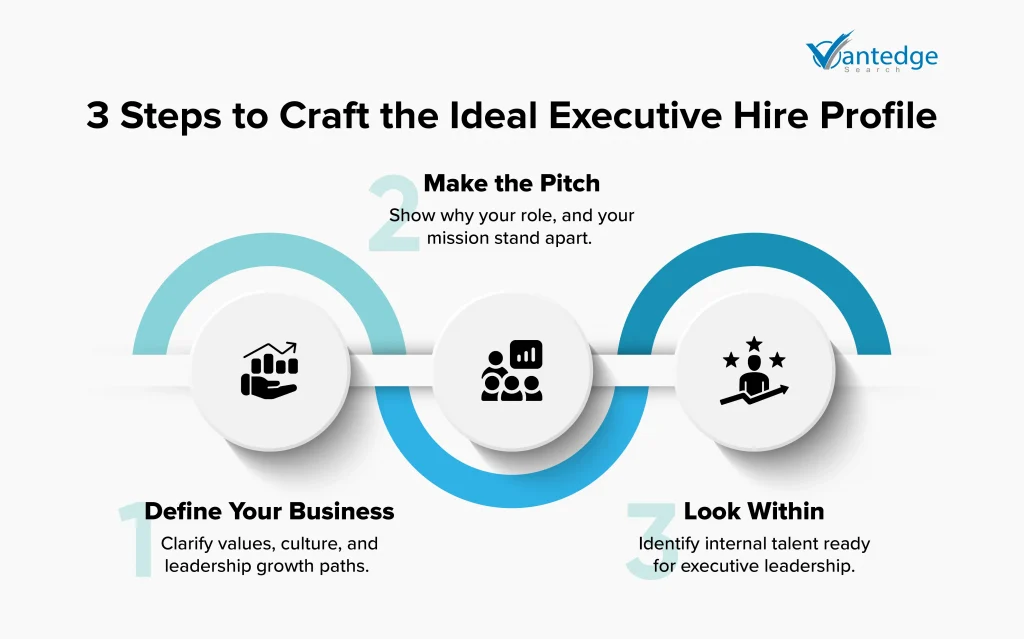
Executive Leadership Recruitment: Crafting the Ideal Candidate Profile
- Executive leadership recruitment is no longer just about matching résumés to roles it’s about aligning leadership vision with business outcomes. The ideal candidate profile acts as a strategic lens, bringing clarity to what success truly looks like in a C-suite hire.
- Done right, it accelerates alignment across boards, founders, and CHROs while helping top talent see the role as a purposeful, long-term move. It also surfaces internal leaders who already embody your culture and are ready to scale impact.
- With the right search partner, recruitment becomes a structured, insight-driven process, not a gamble.
- Read further to learn how to craft a profile that sets your next executive hire up for lasting success.
Designing an executive candidate profile is a crucial step in executive leadership recruitment, helping organizations attract talent that not only fits the role but also aligns with company culture and long-term goals.
Hiring the right executive has become one of the toughest challenges for organizations worldwide. According to the Manpower Survey, 69% of U.S. companies struggle to find the ideal candidate for key positions a gap that often leads to delayed decisions and costly mis-hires.
Creating a well-defined candidate profile is one of the most effective ways to address this issue. But building one isn’t as simple as listing qualifications or leadership titles. At the executive level, it’s about identifying the leadership qualities, cultural compatibility, decision-making approach, and future readiness that matter most to your business.
This blog talks about why leadership hiring efforts often fall short, what makes a candidate’s profile different from a job description, and how to build one that strengthens your executive search strategy from the start.
Why Executive Leadership Recruitment Fails (And How to Fix It)
Despite the best efforts, executive leadership recruitment often falls short not because companies aren’t trying, but because they’re starting with the wrong input. Too often, leadership hiring begins with a broad job description or a wish list of qualifications, without a clear understanding of what success actually looks like in the role.
When the profile lacks depth, the search becomes more reactive. Teams end up screening resumes instead of identifying leaders. The process becomes drawn out, misaligned, and costly both in time and missed opportunity.
A strong executive recruitment process begins with clarity. That means going beyond responsibilities and qualifications. It involves asking: What kind of leader will thrive here? How do they make decisions? What values should they bring into the boardroom?
This is where a well-crafted candidate profile makes all the difference. It acts as a guide for your search to help align internal stakeholders, set realistic expectations, and engage the right candidates from the start.
The Role of a Candidate Profile in Executive Leadership Recruitment
An executive candidate profile isn’t just a tactical document; it’s a strategic blueprint that helps organizations attract and assess leadership talent with clarity and confidence. Here’s what makes it essential:
- Provides a clear hiring direction
Like a customer persona, the profile outlines exactly what kind of executive the business needs skills, mindset, leadership approach, and cultural alignment, eliminating ambiguity from the search.
- Improves internal alignment and reduces friction
With a shared understanding of the ideal leader, internal stakeholders’ boards, CHROs, founders can align faster, making the executive recruitment process more cohesive and deliberate.
- Helps organizations communicate value to candidates
A well-built profile doesn’t just define what the company wants, it also reflects what it offers. Culture, values, growth opportunities, and leadership vision are all clearly conveyed.
- Acts as a filter to attract aligned leaders
Unlike a job description, which outlines duties, the candidate profile focuses on leadership compatibility helping organizations attract talent that fits both role and culture. - Supports long-term leadership planning
These profiles often evolve into internal benchmarks that help track leadership effectiveness, succession readiness, and future hiring needs over time.
Want sharper alignment in leadership hiring?
Define the right fit early.
Step-by-Step: Executive Leadership Recruitment Process
Developing an executive candidate profile is not just about identifying skills, it’s about articulating the kind of leadership your business truly needs. It requires a blend of introspection, positioning, and precision. Here’s how to approach it:
Step 1: Define Leadership Needs for Executive Recruitment
A generic job description is no longer enough to attract top-tier executive talent. Candidates today are evaluating companies as much as companies are evaluating them. That’s why your profile must clearly reflect your identity and values.
- Define your organization’s core culture, leadership philosophy, and working environment.
- Highlight values such as safety, inclusion, and ethical leadership, especially those that matter to today’s leaders.
- Clarify what success looks like beyond the role: growth paths, internal mobility, leadership development programs, and performance expectations.
If your organization offers structured career progression, leadership coaching, or market-competitive benefits, say so. These are not just perks; they’re signals of commitment that help the right candidates connect with your mission.
Step 2: Make the Pitch: Why Should They Choose You?
Executive recruitment is a two-way decision. The best leaders are selective and future focused. A well-crafted profile should position your opportunity as a long-term move that’s both meaningful and career-defining.
Include specifics such as:
- The executive role’s strategic scope and influence
- Your existing leadership team’s composition and background
- The company’s vision, long-term goals, and current market position
- How the executive will shape outcomes financially, operationally, and culturally
This is where your executive role must stand apart. Why should a high-performing leader commit years of their career to your organization? Your candidate profile must answer that clearly and credibly.
Step 3: Align Executive Leadership Recruitment with Company Culture
Sometimes the ideal executive hire is already within your organization. Your top performers already understand your environment, values, and operational realities. They’ve delivered results and they may be ready to take on a bigger role.
- Regularly engage your high performers about their aspirations, challenges, and leadership readiness
- Ask how they solve problems, build momentum, and support their teams’ insights that can shape the executive profile itself
- Use their behaviors and attributes as a benchmark for the external search, ensuring cultural continuity even when hiring from outside
This internal lens not only improves hiring accuracy but helps define what leadership looks like in your unique context grounding your search for lived success, not theoretical fit.

Partnering for Executive Leadership Recruitment Success
Creating a candidate profile is a critical foundation, but executive leadership recruitment rarely succeeds in isolation. Partnering with the right executive search firm can mean the difference between a good hire and a transformational one.
Why? Because executive recruitment isn’t just about matching a résumé to a role. It’s about understanding your business’s context, culture, leadership gaps, and future trajectory, then mapping that to the kind of leader who will succeed not only on day one but in year five and beyond.
Here’s where a search partner adds strategic value:
- Deep industry perspective: Specialized firms offer nuanced knowledge of leadership trends, emerging role expectations, and how the market is shifting insight that helps refine your profile further.
- Access to off-market talent: Many top-performing executives aren’t actively job-seeking. A trusted search partner knows how to reach, engage, and evaluate passive candidates discreetly and effectively.
- Objective candidate assessment: Beyond credentials, they assess how well a leader aligns with your cultural expectations, leadership style, and business stage, reducing guesswork and bias.
- Support through internal alignment: One of the most overlooked challenges in executive hiring is internal misalignment. A good partner helps navigate differences among boards, founders, and CHROs, ensuring clarity before the shortlist is built.
- Process discipline: From building an outreach narrative to managing stakeholder feedback loops, the right partner brings structure, speed, and professionalism to an otherwise fragmented process.
More importantly, a true executive search partner becomes an extension of your leadership team. They help you make not just a hire but a statement about where your organization is headed and who you trust to lead it there.
That’s why choosing the right partner is just as important as building the right profile. Together, they form the foundation of a successful executive recruitment process one rooted in clarity, credibility, and long-term alignment.
Conclusion
Crafting the ideal candidate profile is a strategic anchor for every successful executive leadership recruitment effort. It provides clarity, alignment, and focus on what is often a high-stakes, high-impact process. A well-defined executive profile helps organizations reduce missteps, invest in recruitment budgets wisely, and align leadership hiring with long-term business goals.
At Vantedge Search, we partner with boards, founders, and leadership teams to translate vision into talent. From defining the right candidate profile to executing a precise executive search strategy, we bring insight, discretion, and speed to every engagement.
Let’s help you secure leadership that fits not just the role, but the future you’re building.
FAQs
Executive leadership recruitment is the process of identifying, engaging, and hiring senior leaders such as CEOs, CXOs, and functional heads who can drive long-term business outcomes. It goes beyond filling a role; it’s about aligning leadership capabilities with the organization’s vision, culture, and growth trajectory.
It’s high stakes. Mis-hires at the top can set a company back years. The challenge lies in balancing experience, leadership style, cultural fit, and long-term potential often with limited visibility into passive or off-market talent. Internal misalignment among stakeholders also slows down the process and adds risk.
Start with clarity. Define what success looks like in the role. Craft a candidate profile that reflects your values, growth plans, and leadership needs. Then partner with a specialized executive search firm that understands your business context and can access top-tier talent beyond the job boards.
A strong profile is not a job description. It’s a strategic blueprint that captures the mindset, decision-making approach, cultural compatibility, and future-readiness you expect in a leader. It should reflect not only what your business needs, but why a high-performing executive should choose you.
While timelines vary based on role complexity and market conditions, most retained executive searches take 8–16 weeks from profile definition to final offer. The process involves research, outreach, vetting, interviews, and internal alignment which, done right, leads to a better long-term fit.

